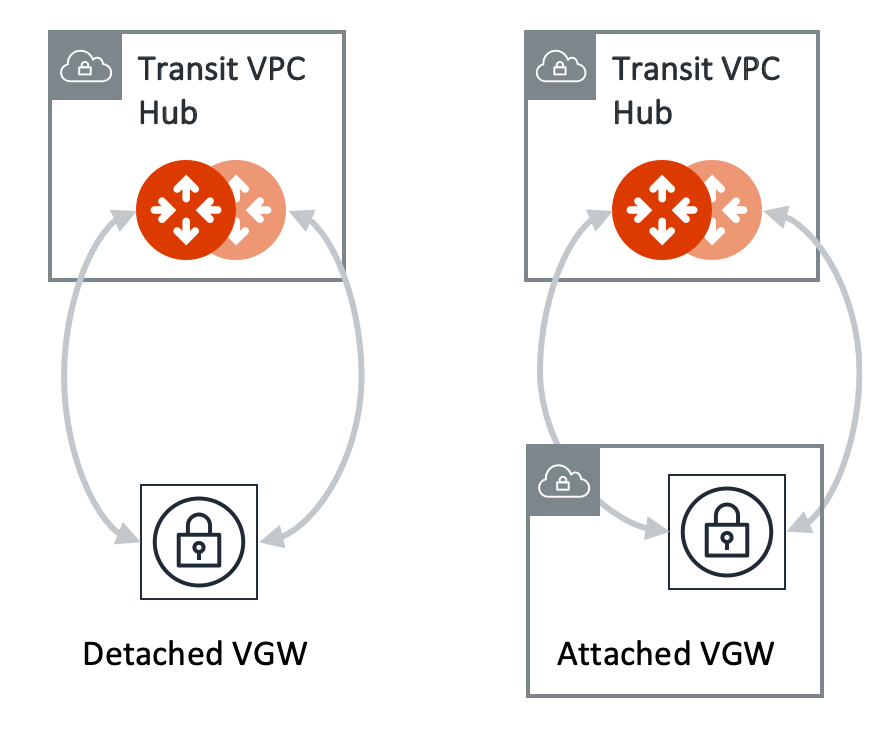Transit Gateway Integration with AWS VGW Workflow
Aviatrix automates the process of discovering and connecting Aviatrix Transit Gateway to AWS VGW.
Before connecting an Aviatrix Transit Gateway to AWS VGW, a VGW must have already been created on the AWS console. In the AWS console, note the VGW ID that is created for the VGW.
When you setup the connection by providing the VGW ID, a Customer Gateway and a Site2Cloud connection between the VGW and the Aviatrix Transit Gateway will be automatically created. The Site2Cloud IPsec tunnel establishes a BGP session to exchange routes between on-premises and the cloud.
After successful creation of the connection, you can view connection in the AWS console by navigating to Customer Gateways and Site-to-Site VPN Connections.
| You are responsible for building the connection between VGW and on-premises. The connection is either over the Internet, over Direct Connect, or both. |
Aviatrix supports two types of connections: Detached VGW and Attached VGW.
|
The VGW should not be attached to the Transit VPC or VNet. The VGW can be attached to a VPC or VNet in a different AWS account in a different region. |

Connecting Transit Gateway to AWS VGW
This document describes the workflow to connect an Aviatrix Transit Gateway to an AWS Virtual Private Gateway (VGW).
| The procedure below assumes the AWS VGW is already deployed in the Transit VPC. |
To connect the Transit Gateway to AWS VGW (VPN Gateway):
-
In Aviatrix CoPilot, go to Networking > Connectivity > External Connections (S2C) tab.
-
From the + External Connection dropdown menu, select AWS Virtual Gateway.
-
Enter the following values:
Field Description Name
A name to identify the connection to the VGW.
Local Gateway
The Transit Gateway to connect to the VGW.
Local ASN
The BGP AS Number the Transit Gateway will use to exchange routes with the VGW.
VGW Account Name
The name of the AWS access account with which the VGW was created.
VGW Region
The AWS region where the VGW is located.
VGW ID
The unique identifier for the VGW.
Manual CIDR Approval
This is Off and disabled by default unless the Local Gateway you select has Manual Learned CIDR Approval turned On for Connection Level. Then it is On by default (not editable).
-
Click Save.
The new AWS VGW connection appears in the table.
It takes a few minutes for the VPN connection to come up and routes from VGW to be propagated. When the IPsec tunnel with a VGW is up, the Controller admin should receive an email notification.
If you log in to the AWS Console and select service VPC in the region where the VGW is, you should see that the Customer Gateway and VPN Connections have been created. Do not delete or modify them from AWS Console. These resources are deleted if you disconnect the VGW.
Checking Route Propagation
You can check if routes are properly propagated.
-
Go to Diagnostics > Cloud Routes > BGP Info.
-
In the table, next to the name of the Transit Gateway used in the above external connection.
-
Click the vertical ellipsis
 and select Show BGP Learned Routes to display the total number and list of routes propagated from the VGW.
and select Show BGP Learned Routes to display the total number and list of routes propagated from the VGW.
Checking Tunnel Status
You can check the tunnel connection between the AWS VGW and the Transit Gateway from Diagnostics > Cloud Routes > BGP Info. Expand the Transit Gateway in the list and check that the Status column shows Established.
If some external connections for the selected Transit Gateway are Not Established, the overall BGP Status for the Transit Gateway is Partially Established.